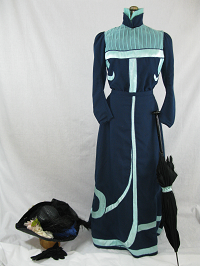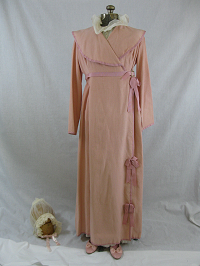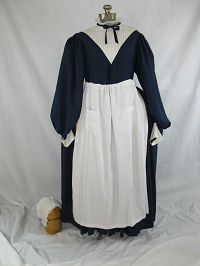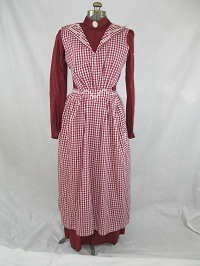
- Details
- Category: 19th century
- Hits: 2513
1830s
The inspiration for this gown was a print from Godey's Ladies Book and October of 1831. During this romantic era the bonnet was introduced. It was said to defend a lady from the stray looks of a beau. This bonnet, made of satin to match her gown, was formed of buckram and decorated with lace and flowers. Ribbons could be tied or left to fly loose. The pocket, called a reticule, is of white on white embroidered cotton. Velvet was used to emphasize the width of the skirt and the line of the drop shoulders. Since the silk of the day was only woven 20 inches wide, two widths would be needed to form the large leg-o-mutton sleeves. Cushions stuffed with feathers were used to keep them puffed. The skirt is also held out by a large cushion. Fashion called for skirts with diameters of five feet. One maid placed three feather dusters beneath her skirt to go walking on Sunday. Full skirts were even worn in factories. The hazard of this was noted in the newspapers of the day, with women dying when their gowns became entangled in the machinery. Fire was also a killer if they brushed too near the fireplace.
Stiff petticoats also helped hold out the skirts of the gowns. Beneath the dress are not only the cushions and several petticoats but a chemise, a corset, a corset cover, and bloomers. Her shoes are still flat and she is wearing white stockings.
- Details
- Category: 19th century
- Hits: 2785
1897
A braid of satin put on cloth (wool) was greatly in favor for winter in 1897. The more elaborate the pattern the better. This gown of dark blue smooth faced cloth is noticeably smart and the lines of satin taffeta trimming are designed to flow pleasingly down the front and toward the back. The pattern is carried out on the waist. The sleeves and the square epaulettes over the top of the sleeves. The unusually deep rounded yoke is of tucked sheer silk. A high collar, with its inside frill of green, is of the cloth like the bodice. All bodices had high necks which were stiffened with boning to keep the head back and the chin out. By 1897 the bodices started to pouch in the front. Fullness has slipped into the bodice and a new chest out look developed. A large hat of fine black straw trimmed with blue and black feathers. The brim is turned up in the back showing several more roses. Parasols were long and used as walking sticks. 1890’s skirts were completely lined and had added extra stiffening and cording along the hem. Along the bottom to catch the dust was a brush braid. This collected the worst of the mud, for the skirts swept the roads however carefully you might hold them up behind. Afterwards the crusted mud had to be brushed off which might take an hour or more to do. A fashion journal warned one of the most disastrous aspects of the raised skirt is when the silk underskirt is caught higher than the transparency and reveals . . . well . . . anything there is to be revealed. The appeal of these seductive garments became audible with their suggestive frou-frou. Only a mature woman could wear the fashions of the day to advantage.
This reproduction was made by Peggy Fields based on an image in Blum 1974: 284 for Nancy Stout one of her models.
Click the image for detailed views.
- Details
- Category: 19th century
- Hits: 3086
1821
According to a fashion magazine of the time called a la chambre or wrapping dress, was worn in the morning before getting attired for the events of the day. This recreation of an 1821 gown is of pink corduroy. The bodice comes up to the throat in the back, but is sloped in the front, and turns over all around so as to form a pelerine. It wraps across before and displays a little of the fichu, or chemisette worn underneath. The sleeve is easy, but not wide, and is finished with gros de Naples at the waist. The girdle is the same, and fastens with a gold clasp at the side. The skirt wraps across to the left side and has corresponding bows down the front.
The headdress is a coronet composed of full bands of net inserted between plain ones of letting in lace. The ears are cut very narrow and far back. It fastens with a bow of pale pink ribbon under the chin. The black leather shoes, called straights, remained little changed for forty more years.
This reproduction was made by Peggy Fields.
Click the image for detailed views.
- Details
- Category: 19th century
- Hits: 2608
1830s
During the 1830s, wasp waists, full skirts, and leg o’mutton sleeves ushered in a new era. Primness and prissiness were virtues. A girl was supposed to swoon at the word “leg” and faint at the term “breast.” Prudery was perfection. The era was a time of cleanliness and scented soaps. Toilet water became a must. Cosmetics consisted of lampblack for mascara, and the dye rubbed from a wet red ribbon provided a delicate rose tint to the cheeks. Women bit their lips vigorously before entering a room to add lip color.
This modest navy blue cotton gown would have been appropriate for a prim school teacher. By the 1830s, the large leg o’mutton sleeve had expanded to such an extent that it needed extra support in the form of down-filled pads stiffened with interlining or whalebone stays. Covering the front of the dress is the ever present apron.
The neckline has widened and the top of the armhole moved out onto the shoulder. Wide collars (and mancherons) gave further emphasis to this part of the body. Here we have a V-shaped chemisette inset used to accent the shoulder line.
During this time, a cushion or pad was once again used to hold out the skirt. We used a quilted, stiffly starched petticoat to support the skirt. By this time, the petticoat had evolved into a true undergarment. Cording and braided straw were also added to help stiffen the skirt.
Shoes are flat, made of cloth and similar to 21st century bedroom slippers.
This reproduction was made by Nellie Wright.
Click the image for detailed views.
- Details
- Category: 19th century
- Hits: 2877
1880-1890
This reproduction was made by Peggy Fields based on a garment in the collection of the Huntingdon County Historical Society (Huntingdon, PA).
While many of our gowns are constructed of elegant, costly material, the average woman tried to stay in style by making their own clothing of servicable materials in the newest styles. Clothing was remodeled as the fashions changed. Harper's Bazaar, Godey's, and other fashion magazines displayed yachting, tennis, street and housegowns. But these housegowns were fancy dresses worn by ladies when receiving visitors in their homes. The magazines give little information concerning the clothing worn by the middle or lower class women when working or supervising the everyday household chores. One dress in Huntingdon County [PA] Historical Society collection was probably worn in the 1880s or 1890s for chores. It was worn at the elbows and carefully patched there and other places. We copied it in a maroon pin-dot material. This apron was pictured in the April 1891 issue of the Delineator, also a Butterick fashion book. The pattern was marked as part of a working toilette, and cost $20. It had a cross-stitched pattern along the hem, on the waistband, collar, and pocket. Ours is unfinished. The dress has an easy sleeve to permit movement. The opening is hooked center front to the waistline, then hooks at the side of the front. This gives a smooth neat effect over the stomach. The standup collar is fastened with a pin. This dress is not lined like the fancier outfits so you would need less material.
Click the image for detailed views.
Page 12 of 13




